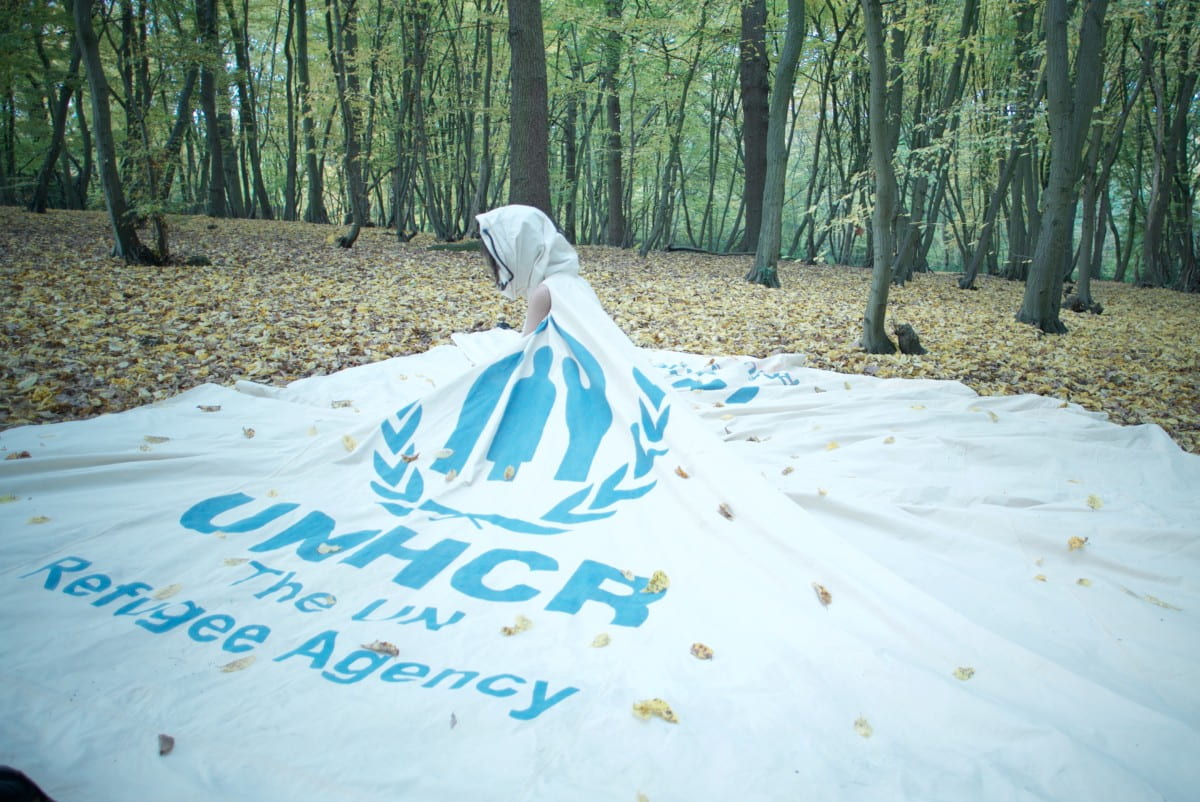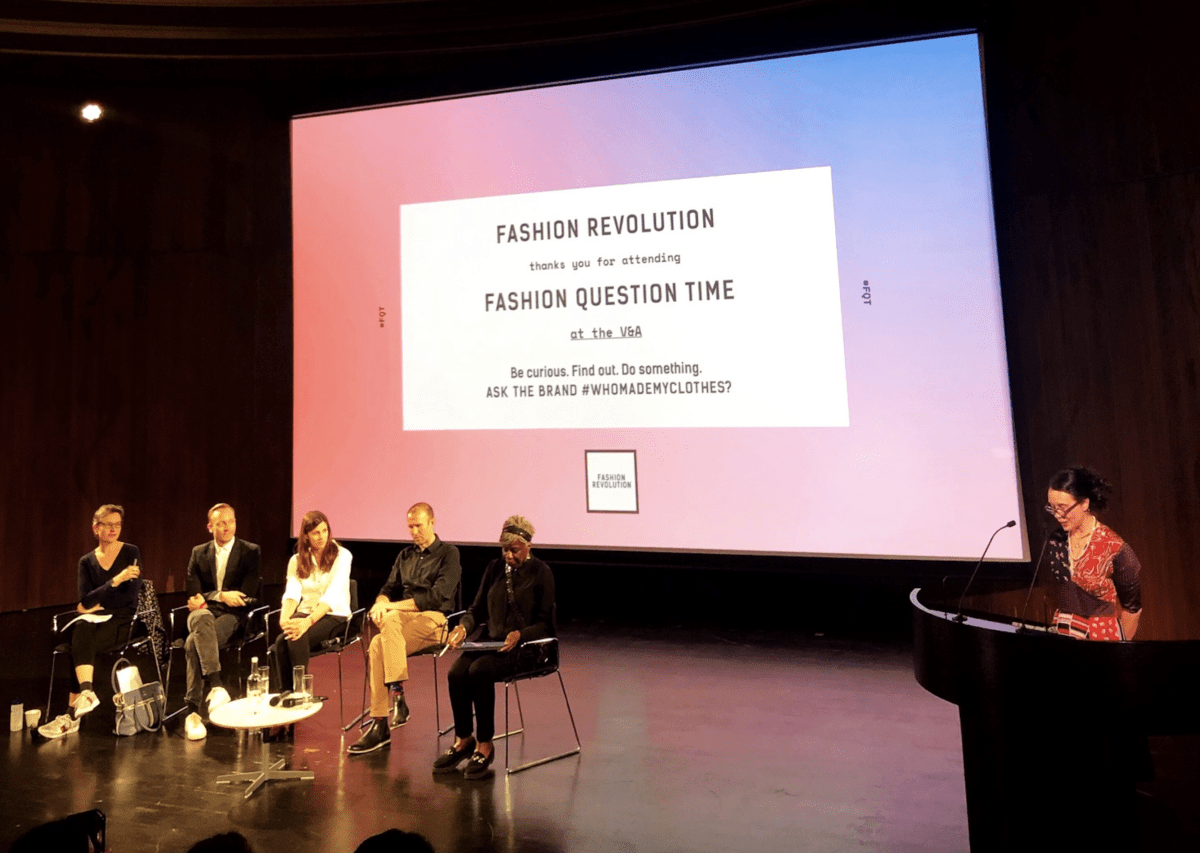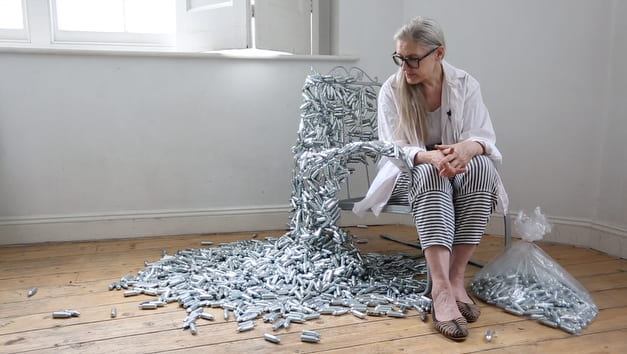I’ve spent a lot of the last decade thinking about fashion image making. It’s one aspect of the history of photography and contemporary photographic practice that has been a focus of my work as a photography curator and writer. I certainly agree with Susan Sontag who said the very nature of thinking is ‘but’, BUT this particular question makes me uncomfortably self-conscious. As I read it back on the page I wonder why I am even asking. So I’m starting by telling you about an experience that I think relates to why I do.

Edward Steichen, Chéruit, as published in Vogue, May 1, 1927
A few months ago, I gave at a postgraduate seminar about a well-known photograph by Edward Steichen taken for Vogue magazine, Chéruit (1927). In my paper I primarily wanted to investigate the way Steichen had used a domestic interior space – Condé Nast’s penthouse apartment at 1040 Park Avenue – as a precursor to the photographic studios set up and run by Vogue magazine in Paris & New York around the time the picture was taken (and in London a decade or so later than that).
My talk was meant as a testing ground for some new ideas but I was shocked that in opening up a group discussion, questions from the floor didn’t get beyond positioning the image in terms of arguments John Berger made in Ways of Seeing about the functioning of the publicity image in 1973. It seemed like the audience, mostly PhD students, were not able to move beyond some very basic assumptions about how a fashion picture made for publication in a magazine could operate. I wondered if I was blinkered? Why had I sought theoretical ideas from this picture if it was, at it’s most reductive, just a smiling woman wearing a dress? Yet I felt sure the author (one of my heroes) wouId shudder that his text, as provocative and important as it was at the time he wrote it, was evoked as a relevant critical context in 2014. I mean I was born in 1973!
Steichen is useful to consider. Despite what I describe above – essentially illustrating the continued pitfalls of discussing a fashion image in an academic context – it is of course widely accepted that his photographs, including his fashion photographs do matter.
Collected by major museums, indeed the subject of a recent comprehensive retrospective which has travelled worldwide for several years (Edward Steichen: In High Fashion, The Condé Nast Years 1923-1937), we are generally comfortable with them as an important and credible photographic contribution. They have been given, what I describe in my book Fashion Photography Next, ‘institutional and historical legitimacy’. The specific photograph of Marion Morehouse I mention above is a good example of how institutional and historical legitimacy can be created. Examining the process reveals much about how a fashion photograph can come to matter.
Let us consider the following: While Steichen’s fashion output was until recently less represented in museum collections, exhibitions and publications, Chéruit was almost immediately presented as an exception. In 1929, only two years after it was taken it was selected by the photographer and his brother-in-law Carl Sandburg as a plate for his first monograph Steichen the Photographer, written by Sandburg and intended as a survey of his most important work to date. The importance of this, of such critical choices in the writing of photo history, of what is included and what is not, needs to be articulated as it is integral to the works longevity of view and ultimately it’s meaning. The photograph has been included in that typically small percentage of any major photographers life’s work which are regarded as canonical despite the fact that in pose (frontal, leg coming forward, arms akimbo), setting (Condé Nast’s lavish apartment) props (use of the diamond patterned floor tiles, floral patterned lounge), model (Marion Morehouse) and lighting (artificially lighted with dramatic shadows), Steichen took many almost identical pictures.
The image was re-printed full page in Vogue when Steichen retired from the magazine in 1938 as an illustration of his significant achievement. In this article he is described as a heroic and active creator/artist: ‘he would move around swiftly, sometimes squatting on his hands and knees to get a camera angle, sometimes appearing to forget all about taking pictures if his subject turned out to be self-conscious’. A decade after being made, the function of his photograph of Marion Morehouse is not as describing fashion but transcending it, where Steichen had ‘outwitted the ungainliness of boy-bob, clipped skirts, (sic) subnormal waist line’.
The photograph was exhibited in the career defining 1961 MoMA retrospective which contained over three hundred works and was timed to coincide with Steichen’s 82nd birthday, incorrectly attributed as having been taken for Vanity Fair in the checklist. This error is in some ways irrelevant because such specifics (who designed the garment, what magazine it was published in etc.) were less important to how the image was understood in this presentation than it’s potential as a representative type of image. Only five fashion images were shown in the entire exhibition which predominately concentrated on his early twentieth century practice as a photo secessionist then later as a portraitist. Removed from the original context of publication in Vogue, the gelatin silver photograph is experienced as a print mounted and framed in a museum or gallery. It is no longer accompanied by graphic headings, text and fashion credits. It is no longer seen as part of fashion story, or as one page in a magazine of well over one hundred pages. In this way it is made singular.
It was also given great significance when Steichen wrote his own history in the biographical picture book A Life in Photography first published in 1963. Here he stakes claim to having produced the first ever fashion photographs, establishes that his salary at Vogue was the highest paid and discusses the development of his technique and mastery of artificial light in the studio. On the one hand he staunchly stands by his work in fashion recounting his directive to Condé Nast that ‘if I made a [fashion] photograph, I would stand by it with my name; otherwise I wouldn’t make it’. On the other, while elevating the picture of Morehouse to that of ‘the greatest fashion model I every photographed’ qualifying their collaboration as something other than fashion stating ‘Miss Morehouse was no more interested in fashion as fashion than I was’. In such discussions the subject of the photograph changes from the dress to the photographer supporting what art theorist Rosalind Krauss calls the historicist model of art writing where values such as authorship, the history of the medium and the coherence of the oeuvre are maintained.
After Steichen captioned the photograph in his biography, the photograph became widely known by his title – Chéruit Gown (Marion Morehouse – Mrs. e.e. Cummings). One wonders if there would have been such an early emphasis on who the model in the photograph was (an interest models became more pronounced in the 1990s with the idea of the ‘super-model’ and the reassessment of key fashion models and the writing of their histories), if Morehouse had not become Mrs. e.e.cummings – surely bestowing added cultural and artistic legitimacy as the subject of the photograph in her own right. This is one way the photograph moves from being about a dress to being about a woman.
In 2010 the image was included as part of a multimedia component of the exhibition American Woman: Fashioning a National Identity organized by the Costume Institute of the Metropolitan Museum of Art exploring how ‘representations of American women established the fundamental characteristics of American Style’. Similarly in the 2013 exhibition Edward Steichen & Art Deco Fashion at the National Gallery of Victoria (NGV), Steichen’s fashion photographs were placed on display in relation to garments from the period in the NGV’s collection. In this context Chéruit also supported a discussion of the new roles of women in American society – Morehouse’s stance and what she wears symbolizing the confidence and independence of the flapper. Now Morehouse becomes more than herself, more than a portrait, she becomes an archetype.
If the NGV cleverly co-opted the image to support an argument in an exhibition about fashion design and gender politics I was amused and interested to see the effect in reverse in the recent The Fashion World of Jean Paul Gaultier. A separate piece could be written about the use of fashion photography in exhibitions of fashion design, and in particular this exhibition. It was wonderful to see his Nude Dress presented on the mannequin directly quoting the pose and styling of the well known photograph by Paolo Roversi of Naomi Campbell in the outfit (Naomi Campbell in front of the Michou cabaret, Rue des Martyrs, Paris, 1994). The image was hung on a near by wall in the show.
It is much easier to demonstrate that historically/institutionally legitimized fashion photography matters than to do the same with contemporary images. It is more difficult again when those images are made by photographers who are new generation or emerging. This was something I thought sought to address when developing the exhibition Don’t Stop Now: Fashion Photography Next currently showing at the Fashion Space Gallery, London College of Fashion. In selecting the group of thirty five photographers for the book all of whom I characterized as new generation, I was saying that their work matters. Yet I was not saying that all contemporary fashion photography matters, or it matters just because it is new.
It seems to me there is a tendency to lump fashion photography into a simplistic conceptual framework of being commercially driven and creatively limited. It’s an easy option, rather than thinking critically and acknowledging a very simple and obvious truth – that like any photographic genre not all fashion images have the same value and that these values inevitably shift and alter. This is evident tracking the history of Steichen’s photograph. I make this point in the book using the example of an anonymous catalogue photograph of a garment on an online fashion boutique which is technically a fashion photograph, just as a passport photograph is also portrait. Generally speaking, neither of these are of great value beyond their functional purpose and if they ever are, it’s an exception rather than the rule. I’d like to take this a little further here, drawing in discussion that came out of the round table conversations that were a part of the public programs accompanying the opening of the exhibition at Foam Photomuseum in Amsterdam in July 2014. I was part of a discussion chaired by Eleanor Weber (my co-contributor to the book) which also included Tyrone Le Bon, Jamie Hawkesworth and Daniel Evans and Brendan Baker. All are making vibrant, original and meaningful fashion images that matter. Yet all also agreed that there was work they had produced at one time or another which was a compromise, be that because of the nature of a commission, a restricted brief or a client expectation at odds with a creative outcome. Not every single image, made by any single photographer, emerging or established, fashion or otherwise, needs to matter. Indeed if they did, nothing would end up mattering very much.

Installation shot from Don’t Stop Now: Fashion Photography Next, Part 1, Fashion Space Gallery London College of Fashion
Reconsidering the exhibition after it’s opening in London and with my starting question in mind, I would say it demonstrates that fashion photography matters in several structural or industry based ways. We can see it as continuing to offer a platform for experimentation and alternative voices via underground, independent and self-publishing opportunities both online and in print. Significantly we can observe that more than ever before it provides a more visible and economically sustainable trajectory for women photographers to work as equals with their male counterparts even at a global multi-national level. We can be glad that at best it still fosters creative collaboration and exchange at a community or collective level. And contrary to expectation it has not been reduced to a singularly digital genre, but indeed has flourished recently through a combination of digital and analogue techniques. This is not to gloss over ongoing issues including a prevalent and insidious false economy where young photographers, stylists, and models do not get paid (or are paid very little) for significant but costly editorial, resulting in photographers essentially financing fashion magazines in the hope of having a story published. Or the pressure for photographers and stylists to conform to a magazine’s fashion credits in the supposedly creative outlet of editorial. These are generally luxury global brands that also pay for advertising in the magazine itself.
In Part Two of the exhibition currently on display, we can trace a definite linage of photographic influences particularly in relation to documentary and diarisitc approaches to subject – what I have called ‘Authenticity’. It signals a sophisticated visual knowledge of the history of photography, including fashion precursors, informing this generation of image-makers. Their work matters not because of its ‘fashion-ness’ (i.e. grandiose, extravagant, glamorous), but because it is intimate, revelatory and brave.
In contrast the selection of images concerned with the idea of ‘Artifice’ – that probably looks more like one thinks fashion should, puts paid to the longstanding idea that fashion is frivolous if it is not concerned with the real. This was also apparent in Part One of the exhibition dealing with ‘Play’; where abstraction, relational concerns and intervention in photographic process though arrangement marked a conceptual challenge to the idea of truth or objectivity. Fashion that revels in fantasy no longer ‘sells dreams’, but invites us to contemplate narratives that can be complex, dark, absurd, obscure and humorous. Though they do, I’m yet to meet a fashion photographer who tells me they set out to sell a dress (or a dream for that matter). In Part Two of the show I would suggest we see a generation of image makers intent on telling stories – about themselves, their friends and the world around them as well as stories from their imaginations. Ultimately too it is clear they all want to make good photographs.

Chardchakaj Waikawee, from the series Youth.
More individually (image by image) we see that fashion photographs can matter because they are funny, personal, political, confronting, conceptual – and then all these things and extraordinarily beautiful. I have purposefully not discussed the pictorial style of any one photographer in this piece as this is done comprehensively in the book. To conclude, I wish to make an exception for the work of Bangkok based Chardchakaj Waikaee. He is less well known that some of his peers, yet his documentary based work embodies the qualities above in a deceptively straight forward, then ultimately surprising and subversive way. This is particularly evident in work that challenges social structures, our pre-conceptions of the urban fringe and what it is to be fashionable. That he lives and works predominately outside of the still dominant centers of New York, London and Paris makes this all the more remarkable.
So if fashion photography doesn’t matter please do tell me why ‘BUT’ don’t expect me to stop – now, next or ever.
Magdalene Keaney has written widely on photography including for Acne Paper, American Photo, Aperture, British Journal of Photography, Chinese Vogue, Exit, Portfolio, Photofile and ShowStudio. Contributions to exhibition catalogues and books include Stephen Jones & the Accent of Fashion’ (MoMu 2009), ‘Yohji Yamamoto’ (V&A 2010), ‘British Ballgowns’ (V&A 2012) and Yamamoto & Yohji (Rizzoli 2014). Keaney was Associate Curator of Photographs at the National Portrait Gallery, London, where she curated ‘Irving Penn Portraits’ (2010). In 2010 she was appointed as the inaugural Creative Director of the Fashion Space Gallery at London College of Fashion. Her book ‘Fashion Photography Next’ (Thames and Hudson) was published in July 2014 at the same time an associated exhibition ‘Don’t Stop Now: Fashion Photography Next’ was opened at FOAM photomuseum in Amsterdam. The exhibition was co-produced and is currently showing at the Fashion Space Gallery, London College of Fashion. Keaney is currently completing her PhD at the Centre for Art History and Art Theory, Australian National University, Canberra.




